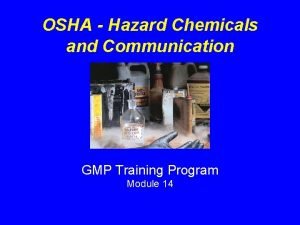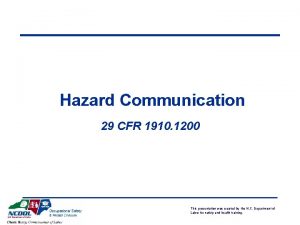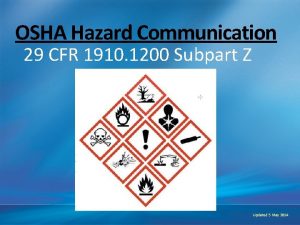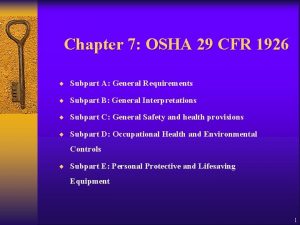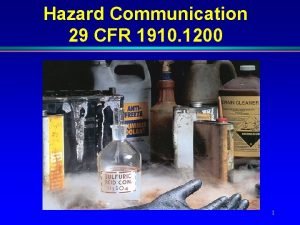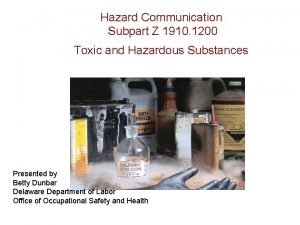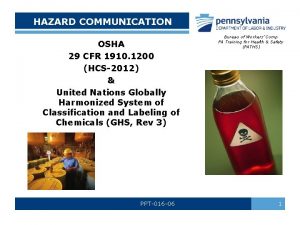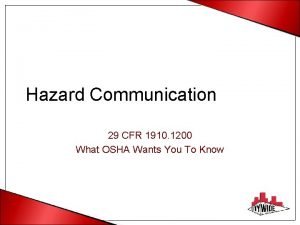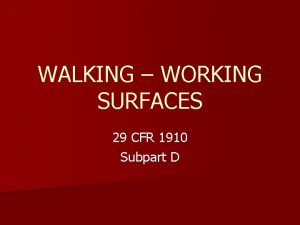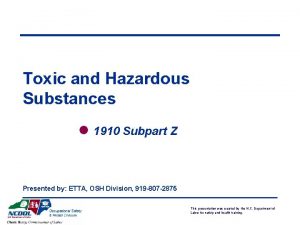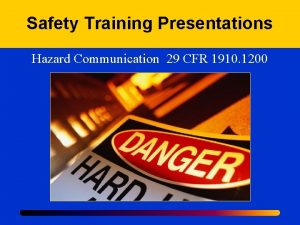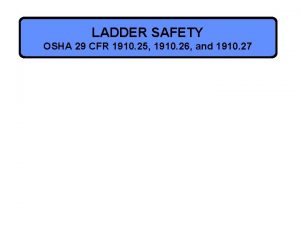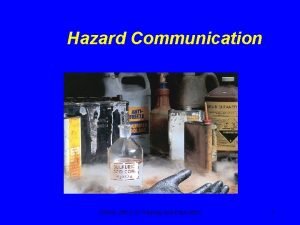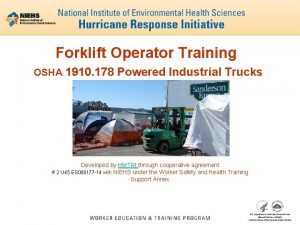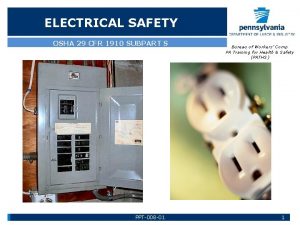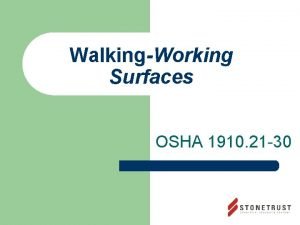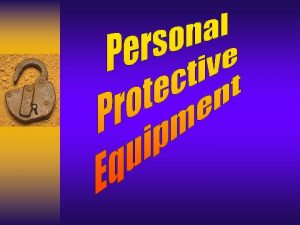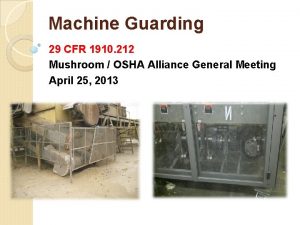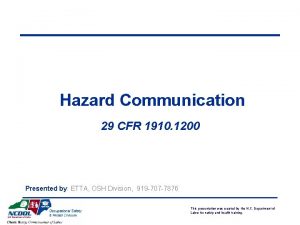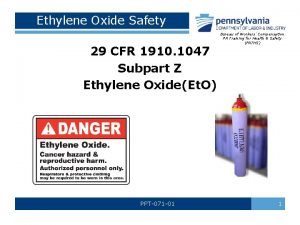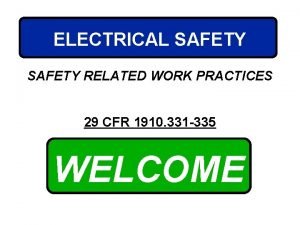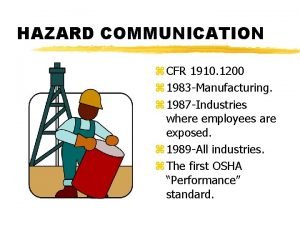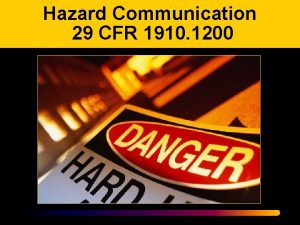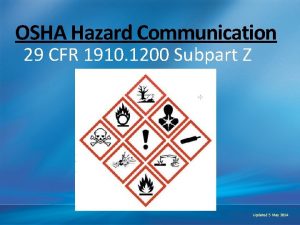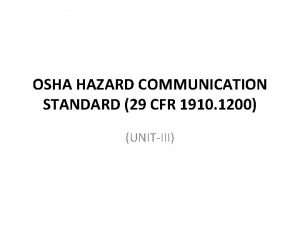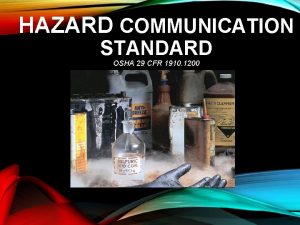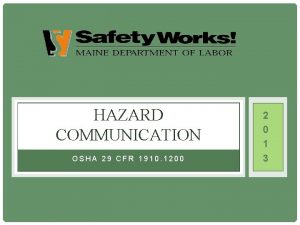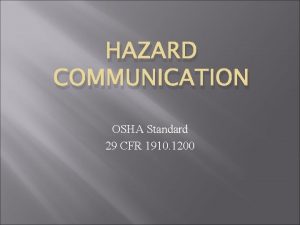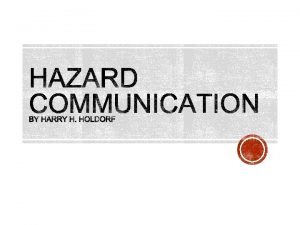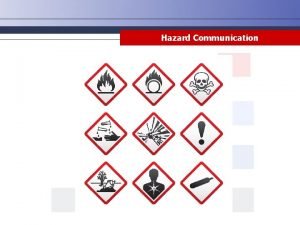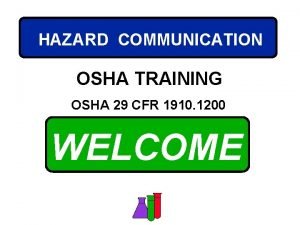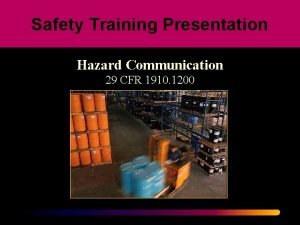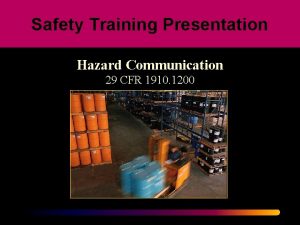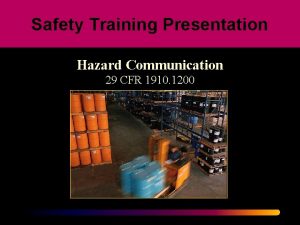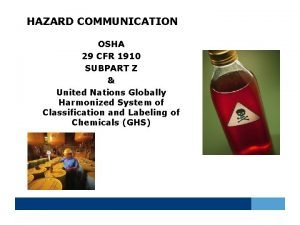Hazard Communication 29 CFR 1910 1200 Compliance Training

























- Slides: 25

Hazard Communication 29 CFR 1910. 1200 Compliance Training Presentation

Hazardous Communication • Purpose of the Standard: – To ensure that all chemicals produced within, or imported to, the United States are evaluated – To ensure that the information regarding their hazard is communicated to employers and employees • By a hazardous communication program • Program to include labeling, MSDS, and training

Hazardous Communication • Scope of the Standard: – Requires chemical importers and manufacturers to assess the health hazards of these chemicals – Requires that they communicate these hazards to employers and label the chemical containers – Requires employers to communicate this information to employees

Hazardous Communication • This Standard is applicable to: – Employers who use chemicals in the workplace – Manufacturers of hazardous chemicals – Distributors of hazardous chemicals

Hazardous Communication • This Standard does not apply to: – Pesticides – Food, drug, cosmetic, or medical products – Alcoholic or malt beverages – Consumer product or hazardous substance when used as intended by manufacturer – Agricultural or vegetable seed treated with pesticides and labeled accordingly – Hazardous Waste

Hazardous Communication • Not applicable continued… – Tobacco or tobacco products – Wood or wood containing products (Note: Wood which has been treated with a hazardous chemical is covered by this Standard) – Nuisance particulates that do not pose a health hazard – Biological hazards

Hazardous Communication • Specific employer responsibilities: – Assure that labels on containers of hazardous chemicals are not removed or defaced – Maintain copies of all Material Safety Data Sheets for hazardous chemicals used in the workplace – Maintain a written Hazard Communication Program • Consult NPCA Guide to Plant Safety – Train employees on Hazardous chemicals, MSDS’s, and the written program • Who can train? – Qualified Person of Competence • How Often? – At Orientation – Annual Review – When a New Chemical is introduced into the workplace

Hazardous Communication • The written program – Employers have to develop a written program, maintain it at each workplace, that describes how the criteria contained within this Standard will be met – The program will include: • A list of chemicals present referring to an MSDS • Method of informing employees about nonroutine hazards • Location of written program and MSDS’s – “Right to Know Center”

Hazardous Communication • The written program continued… – Must provide instructions for labeling containers holding chemicals – Must explain what to do when transferring a chemical to another container

Hazardous Communication • The written program continued… – Where multiple workplaces are present, or when employees must travel between workplaces the written program may be kept at the primary workplace facility – It is, however, strongly recommended that road crews carry copies of all applicable MSDS’s with their crew in condensed MSDS Packets

Hazardous Communication • Labeling hazardous chemicals – Label all chemicals in the workplace with the following minimum information • Identification of the hazardous chemical • Appropriate hazard warnings • Name and address of the chemical manufacturer – The label for solid materials (steel, concrete, etc. ) may be transmitted to the customer at the time of initial shipment and can be sent with the MSDS

Hazardous Communication • Labeling hazardous chemicals continued… – When transferring a chemical to another container, the new container needs to be labeled unless it is for immediate use only • Ex. Immediate= 1 Shift – The employer may not remove or deface existing labels unless the container is immediately marked with the information – Labels will, at a minimum, be in English. Additional translations may also be present.

Hazardous Communication • Material Safety Data Sheets (MSDS) – The employer must have a MSDS for each hazardous chemical which they use – The MSDS will be, at a minimum, in English – The MSDS will contain at least the following • Identity used on the label • If the chemical is a single substance or mixture • Mixtures not tested as a whole shall list each ingredient that is ≤ 1% of the composition, or carcinogens that are ≤ 0. 1% of the composite

Hazardous Communication • MSDS continued… – The MSDS will contain at least the following • The chemical and common name of all ingredients which have been determined to present a physical hazard when present in a mixture • Physical and chemical characteristics: – – – Vapor pressure Flash point Density Color Other characteristics as necessary

Hazardous Communication • MSDS continued… – The MSDS will contain at least the following • The physical hazards of the chemical – Potential for fire – Potential for explosion – Potential for reactivity • The health hazards of the chemical, signs of exposure, and recognized medical conditions caused by exposure

Hazardous Communication • MSDS continued… – The MSDS will contain at least the following • The primary routes of entry • The permissible exposure limits • Whether the chemical is or has the potential to be a carcinogen • Applicable safe handling precautions known • Applicable control measures: – Engineering – Work Practice – Personal protective equipment

Hazardous Communication • MSDS continued… – The MSDS will contain at least the following: • The date of preparation, or latest change to the MSDS • Name, address, and telephone number of the chemical manufacturer, importer, employer, or other responsible party where emergency information can be obtained

Hazardous Communication • MSDS continued… – The employer will make sure MSDS’s are readily accessible to employees during each work shift. – MSDS’s can be available via paper, electronic access, microfiche, or other alternatives. No barriers to employee access can be created by the method of storage.

Hazardous Communication • Practical Tips – Have Your MSDS Book Located: • Where employees are working • In the office – At order placement – request MSDS • Add a Check box on your PO Form – Procedure for reviewing MSDS Book when checking in receiving tickets – Highlight: • Common Name • Emergency & First Aid Procedures

Hazardous Communication • Practical Tips Continued… – MSDS Book should include a quick reference method • Alphabetical Listing with Index Tabs • Identify Location within Facility of all Chemicals – For Quick & Easy Addition of New Chemicals: • • Alphabetize the Table of Contents Assign each Chemical a Reference Number Add New Chemicals to Back of Book with Ref. Number Add to Table of Contents and Reprint Table

Hazardous Communication

Hazardous Communication • Employee information and training – Employers are required to provide training on hazardous chemicals: • At the time of employment • Whenever a new hazard is present • When a chemical is introduced in a new work area – Employees are to be informed of • The requirements of this section • Specific job site hazards present at their work area • The location of the written program and MSDS’s

Hazardous Communication • Employee training elements – Methods and observations that may be used to detect the presence or release of a hazardous chemical in the work area – The physical and health hazards of the chemicals used in the work area – Make a Game out of It! • Ex. Offer an employee a free lunch if given a chemical name they can deliver the MSDS sheet to you within 10 minutes.

Hazardous Communication • Employee training elements continued… – The measures employees can take to protect themselves from these hazards. Include administrative, engineering, and work practices – The details of the hazardous communication program, the explanation of the labeling system, and how the employee can obtain and use this information

Hazardous Communication • For additional information see the following resources: – www. osha. gov – http: //www. cdc. gov/niosh/homepage. html – http: //hazard. com/msds/
 Osha hazard and ghs training regulation cfr 1910
Osha hazard and ghs training regulation cfr 1910 29 cfr 1200
29 cfr 1200 29 cfr1910.1200
29 cfr1910.1200 29 cfr 1910 section 1200
29 cfr 1910 section 1200 29 cfr 1910 section 1200
29 cfr 1910 section 1200 1926 subpart c
1926 subpart c 29 cfr 1200
29 cfr 1200 Ghs explosive
Ghs explosive 1910-1200
1910-1200 1910-1200
1910-1200 D3ladder
D3ladder Osha 1910 subpart z
Osha 1910 subpart z Hazard communication safety training quiz answers
Hazard communication safety training quiz answers 29 cfr 1910
29 cfr 1910 Osha ladders 1910
Osha ladders 1910 Osha cfr 1910 is the standard for______.
Osha cfr 1910 is the standard for______. 29 cfr 1910 powered industrial trucks
29 cfr 1910 powered industrial trucks 29 cfr 1910
29 cfr 1910 Osha 29 cfr 1910
Osha 29 cfr 1910 29 cfr 1910 powered industrial trucks
29 cfr 1910 powered industrial trucks 29 cfr 1910 ppe
29 cfr 1910 ppe 29 cfr 1910
29 cfr 1910 29 cfr1910.1200
29 cfr1910.1200 29 cfr 1910 powered industrial trucks
29 cfr 1910 powered industrial trucks Cfr 1047
Cfr 1047 Osha 1910 electrical panel clearance
Osha 1910 electrical panel clearance
